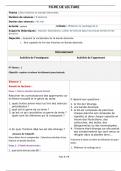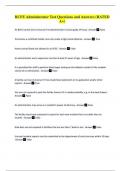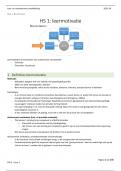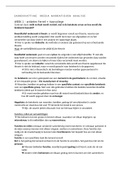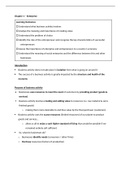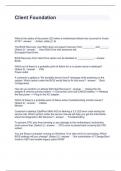Financial Accounting 1 For Business
Chapter 1
Accounting: identifies, records, and communicates the economic events of an organization to
interested users.
Identify the economic events relevant to its business. Recording consists of keeping a
systematic, chronological diary of events, measured in monetary units + summarizing
economic events. Communicate by financial statements, reports data in the aggregate.
Managerial accounting provides internal reports to help users make decisions about their
companies. Detailed, on a timely basis.
External users are investors (owners) and creditors. Financial accounting provides economic
and financial information for external users. Information needs of external users vary
considerably.
Ethics are important for accounting; dishonest financial statements reduce faith of investors.
Accountant has to follow standards that are issued by standard-setting bodies: International
Accounting Standards Board (IASB) and Financial Accounting Standards Board (FASB).
International Financial Reporting Standards (IFRS) are determined by the IASB. Generally
accepted accounting principles (GAAP) are issued by the FASB.
Convergence=the standard-setting bodies make efforts to reduce the differences between
IFRS and GAAP to increase comparability.
There are 2 measurement principles: the historical cost principle and the fair value
principle. Trade-off between relevance (financial information is capable of making a
difference in a decision) and faithful representation (numbers and descriptions match what
really existed or happened). Fair value (relevance) only used in situations where assets are
actively traded (investment securities).
Main assumptions for the accounting process:
Monetary unit assumption=only include transaction data that can be expressed in monetary
terms. Prevents inclusion of health, quality, and morale. Cannot be quantified.
Economic entity assumption=the activities of the entity must be kept separate and distinct
from the activities of its owner and all other economic entities. Economic entities:
- Proprietorship=business owned by one person. Owner is personally liable for all debts of
the business, no legal distinction between the business as an economic unit and the owner.
- Partnership=business owned by 2 or more persons associated as partners. Each partner
has unlimited personal liability for the debts of the partnership.
- Corporation=business organized as a separate legal entity under corporation law and
having ownership divided into transferable shares. Shareholders enjoy limited liability.
Ownership can be transferred without dissolving the corporation -> unlimited life.
Liabilities and equity are the rights or claims against resources (assets). Assets have to
capacity to provide future services or benefits.
Residual equity=the equity left over after creditors’ claims are satisfied. Equity consists of
ordinary share capital and retained earnings. Retained earnings is determined by:
- revenues=the gross increase in equity resulting from business activities entered into for the
purpose of earning income.
,- expenses=the cost of assets consumed or services used in the process of earning revenue.
- dividends=after net income, are not expenses.
(Business) transaction=a business’s economic events recorded by accountants. External
transactions involve economic events between the company and some outside
enterprise/customer. Internal transactions occur entirely within one company. Many
activities do not represent business transactions: talking with customer etc.
Supplies last shorter than 1 year, equipment lasts several years.
Financial statements:
1. Income statement presents the revenues and expenses and resulting net income/loss.
2. Retained earnings statement summarizes the changes in retained earnings.
3. Statement of financial position/balance sheet: reports assets, liabilities, and equity.
4. Statement of cash flows summarizes information about the cash inflow (receipts) and
outflows (payments). Negative amounts are presented in (parentheses). Includes operations,
investments, financing activities, change in cash, and the cash amount at the end of the
period.
5. Comprehensive income statement presents other comprehensive income items that are
not included in the determination of net income. Two statement approach.
All statements are over a period of time, while the financial statement is for a POINT in time.
Final sums are double-underlined.
Public accounting: offer expert service to the general public. Auditing=independent
accountant examines company financial statements and provides an opinion as to how
accurately they present the company’s results and financial position. Taxation. Management
consulting.
Private/managerial accounting: employee of company. Cost accounting, budgeting, internal
audit team.
Forensic accounting: uses accounting, auditing, and investigative skills to conduct
investigations into theft and fraud.
Chapter 2
Account=an individual accounting record of increases and decreases in a specific asset,
liability, o equity item. Capitalize the name. Includes title, left/debit side, and right/credit
side =T-account. Balance is determined by subtracting the 2 sides.
Debit=Dr=left side account, credit=Cr=right side. Do NOT mean increase/decrease.
Double-entry system=each transaction must affect 2 or more accounts.
Normal balance=on the side where an increase in the accounts is recorded (debit for assets,
credit for liabilities). “Abnormal balance” (e.g. credit cash account) can sometimes be
correct.
Recording process: analyse transaction -> enter in journal -> transfer to ledger.
Journal=the book of original entry (chronological order).
General journal includes dates, titles and explanations, references, and debit & credit.
Reference is left blank while the entry is made, is used when the journal is transferred to the
ledger. Explanation is written on the line below the credit account title.
, Simple entry=transaction that requires 2 accounts.
Compound entry=transaction that requires more than 2 accounts.
Ledger=the entire group of accounts maintained by a company. Accounts are numbered for
easier identification. Uses three-column form of account: debit, credit & balance. Also has
an explanation (is used infrequently), date, and reference column.
Posting=transferring journal entries to ledger accounts.
Chart of accounts=chart that lists the accounts and the account numbers that identify their
location in the ledger. Gaps are left to permit the insertion of new accounts as needed
during the life of the business.
Advanced payments (services are not yet completed) are recorded as unearned revenue.
Paid rent and dividends INCREASE the accounts, since it decreases equity.
Trial balance=a list of accounts and their balances at a given time. List accounts in order of
appearance in ledger (from low numbers to high). List the account titles and their balances,
total debit and credit columns, prove equality. Trial balance brings errors to light. However,
errors may still exist when balance is equal. Solutions: 1/10/100$ error: recompute balances.
Divisible by 2: scan for balance of half the error that has been entered in the wrong column.
Divisible by 9: transposition error=reversing order of numbers (12 is listed as 21), incorrectly
copied from ledger. Not divisible: scan ledger/journal for omitted balance.
(to sum a column of figures is sometimes referred to as to foot the column. The column is
then said to be footed) (an error is the result of an unintentional mistake, while an
irregularity is an intentional misstatement)
Only use currency signs in trial balance and financial statements, not in journals or ledgers.
Only place it for the first item of that column and the total. Single line (totalling rule) is
placed under the column of figures to be added/subtracted. Total amounts are double-
underlined to indicate final sums. Negative signs or parentheses do not appear in journals or
ledgers.
Chapter 3 (excl. 3A, incl. 3B)
Time period assumption=accountants divide the economic life of a business into artificial
time periods. Interim periods=time period of a year or a quarter. Fiscal year=time period of
one year.
Accrual-basis accounting=record transactions that change a company’s financial statements
in the periods in which the events occur. Cash-basis accounting=record revenue when you
receive cash -> expenses often do not match revenues, only used by small companies.
Revenue recognition principle=companies recognize revenue in the accounting period in
which the performance obligation is satisfied.
Expense recognition principle/matching principle=efforts (expenses) should be matched
with results (revenues).
Adjusting entries=ensure that the revenue recognition and expense recognition principles
are followed. Needed because trial balance may not contain up-to-date and complete data:
some events are not recorded daily, some costs expire with the passage of time rather than
as a result of daily transactions (rent), some items may be unrecorded. Adjusting entries
Chapter 1
Accounting: identifies, records, and communicates the economic events of an organization to
interested users.
Identify the economic events relevant to its business. Recording consists of keeping a
systematic, chronological diary of events, measured in monetary units + summarizing
economic events. Communicate by financial statements, reports data in the aggregate.
Managerial accounting provides internal reports to help users make decisions about their
companies. Detailed, on a timely basis.
External users are investors (owners) and creditors. Financial accounting provides economic
and financial information for external users. Information needs of external users vary
considerably.
Ethics are important for accounting; dishonest financial statements reduce faith of investors.
Accountant has to follow standards that are issued by standard-setting bodies: International
Accounting Standards Board (IASB) and Financial Accounting Standards Board (FASB).
International Financial Reporting Standards (IFRS) are determined by the IASB. Generally
accepted accounting principles (GAAP) are issued by the FASB.
Convergence=the standard-setting bodies make efforts to reduce the differences between
IFRS and GAAP to increase comparability.
There are 2 measurement principles: the historical cost principle and the fair value
principle. Trade-off between relevance (financial information is capable of making a
difference in a decision) and faithful representation (numbers and descriptions match what
really existed or happened). Fair value (relevance) only used in situations where assets are
actively traded (investment securities).
Main assumptions for the accounting process:
Monetary unit assumption=only include transaction data that can be expressed in monetary
terms. Prevents inclusion of health, quality, and morale. Cannot be quantified.
Economic entity assumption=the activities of the entity must be kept separate and distinct
from the activities of its owner and all other economic entities. Economic entities:
- Proprietorship=business owned by one person. Owner is personally liable for all debts of
the business, no legal distinction between the business as an economic unit and the owner.
- Partnership=business owned by 2 or more persons associated as partners. Each partner
has unlimited personal liability for the debts of the partnership.
- Corporation=business organized as a separate legal entity under corporation law and
having ownership divided into transferable shares. Shareholders enjoy limited liability.
Ownership can be transferred without dissolving the corporation -> unlimited life.
Liabilities and equity are the rights or claims against resources (assets). Assets have to
capacity to provide future services or benefits.
Residual equity=the equity left over after creditors’ claims are satisfied. Equity consists of
ordinary share capital and retained earnings. Retained earnings is determined by:
- revenues=the gross increase in equity resulting from business activities entered into for the
purpose of earning income.
,- expenses=the cost of assets consumed or services used in the process of earning revenue.
- dividends=after net income, are not expenses.
(Business) transaction=a business’s economic events recorded by accountants. External
transactions involve economic events between the company and some outside
enterprise/customer. Internal transactions occur entirely within one company. Many
activities do not represent business transactions: talking with customer etc.
Supplies last shorter than 1 year, equipment lasts several years.
Financial statements:
1. Income statement presents the revenues and expenses and resulting net income/loss.
2. Retained earnings statement summarizes the changes in retained earnings.
3. Statement of financial position/balance sheet: reports assets, liabilities, and equity.
4. Statement of cash flows summarizes information about the cash inflow (receipts) and
outflows (payments). Negative amounts are presented in (parentheses). Includes operations,
investments, financing activities, change in cash, and the cash amount at the end of the
period.
5. Comprehensive income statement presents other comprehensive income items that are
not included in the determination of net income. Two statement approach.
All statements are over a period of time, while the financial statement is for a POINT in time.
Final sums are double-underlined.
Public accounting: offer expert service to the general public. Auditing=independent
accountant examines company financial statements and provides an opinion as to how
accurately they present the company’s results and financial position. Taxation. Management
consulting.
Private/managerial accounting: employee of company. Cost accounting, budgeting, internal
audit team.
Forensic accounting: uses accounting, auditing, and investigative skills to conduct
investigations into theft and fraud.
Chapter 2
Account=an individual accounting record of increases and decreases in a specific asset,
liability, o equity item. Capitalize the name. Includes title, left/debit side, and right/credit
side =T-account. Balance is determined by subtracting the 2 sides.
Debit=Dr=left side account, credit=Cr=right side. Do NOT mean increase/decrease.
Double-entry system=each transaction must affect 2 or more accounts.
Normal balance=on the side where an increase in the accounts is recorded (debit for assets,
credit for liabilities). “Abnormal balance” (e.g. credit cash account) can sometimes be
correct.
Recording process: analyse transaction -> enter in journal -> transfer to ledger.
Journal=the book of original entry (chronological order).
General journal includes dates, titles and explanations, references, and debit & credit.
Reference is left blank while the entry is made, is used when the journal is transferred to the
ledger. Explanation is written on the line below the credit account title.
, Simple entry=transaction that requires 2 accounts.
Compound entry=transaction that requires more than 2 accounts.
Ledger=the entire group of accounts maintained by a company. Accounts are numbered for
easier identification. Uses three-column form of account: debit, credit & balance. Also has
an explanation (is used infrequently), date, and reference column.
Posting=transferring journal entries to ledger accounts.
Chart of accounts=chart that lists the accounts and the account numbers that identify their
location in the ledger. Gaps are left to permit the insertion of new accounts as needed
during the life of the business.
Advanced payments (services are not yet completed) are recorded as unearned revenue.
Paid rent and dividends INCREASE the accounts, since it decreases equity.
Trial balance=a list of accounts and their balances at a given time. List accounts in order of
appearance in ledger (from low numbers to high). List the account titles and their balances,
total debit and credit columns, prove equality. Trial balance brings errors to light. However,
errors may still exist when balance is equal. Solutions: 1/10/100$ error: recompute balances.
Divisible by 2: scan for balance of half the error that has been entered in the wrong column.
Divisible by 9: transposition error=reversing order of numbers (12 is listed as 21), incorrectly
copied from ledger. Not divisible: scan ledger/journal for omitted balance.
(to sum a column of figures is sometimes referred to as to foot the column. The column is
then said to be footed) (an error is the result of an unintentional mistake, while an
irregularity is an intentional misstatement)
Only use currency signs in trial balance and financial statements, not in journals or ledgers.
Only place it for the first item of that column and the total. Single line (totalling rule) is
placed under the column of figures to be added/subtracted. Total amounts are double-
underlined to indicate final sums. Negative signs or parentheses do not appear in journals or
ledgers.
Chapter 3 (excl. 3A, incl. 3B)
Time period assumption=accountants divide the economic life of a business into artificial
time periods. Interim periods=time period of a year or a quarter. Fiscal year=time period of
one year.
Accrual-basis accounting=record transactions that change a company’s financial statements
in the periods in which the events occur. Cash-basis accounting=record revenue when you
receive cash -> expenses often do not match revenues, only used by small companies.
Revenue recognition principle=companies recognize revenue in the accounting period in
which the performance obligation is satisfied.
Expense recognition principle/matching principle=efforts (expenses) should be matched
with results (revenues).
Adjusting entries=ensure that the revenue recognition and expense recognition principles
are followed. Needed because trial balance may not contain up-to-date and complete data:
some events are not recorded daily, some costs expire with the passage of time rather than
as a result of daily transactions (rent), some items may be unrecorded. Adjusting entries



